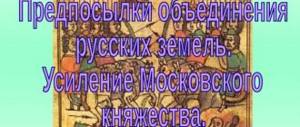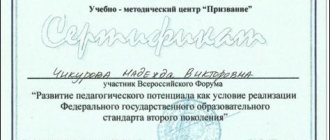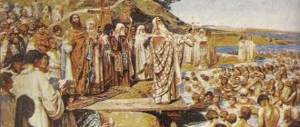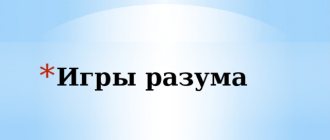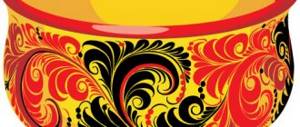Presentation of the lesson “Golden Horde. The system of dependence of Russian lands on the Horde khans"
#6th grade #History #Educational and methodological materials #Material on teaching materials #Subject teacher #School education #Teaching and teaching materials by A. V. Torkunova
IN Z RUSS
“Whoever comes to us with a sword will die by the sword. This is where the Russian Land stood and will stand.”
The significance of the victories of Alexander Nevsky (1236-1252) The “Drang nach Osten” (“onslaught to the east”) was suspended The Orthodox faith was preserved Moral significance (after the invasion of Batu) The growth of the authority and influence of Alexander Nevsky P.D. Corin Alexander Nevsky
Lesson topic: “Golden Horde. The system of dependence of Russian lands on the Horde khans" History of Russia, 6th grade
Homework: Paragraph 18 Questions and assignments on page 33. Workbook No. 1,4.5 Rubric “We think, compare, reflect.” (page 34). Task No. 1.3 (presentation)
Plan: 1. Formation of the Golden Horde. 2. Peoples of the Horde. Religions in the Horde. Economy of the Horde. 3. Horde rule in Rus'. Duties of the population. 4. The struggle of the Russian people against Horde rule. 5. Consequences of Horde rule.
Problematic question! (p. 27) What role did the Golden Horde play in the history of the peoples of our country?
1. Formation of the Golden Horde. 1. Formation of the Golden Horde.
Golden Horde After fierce battles on Russian soil, Batu’s troops had no strength left to capture Europe. The European peoples were saved by Russia lying in ruins. On the eastern borders of the Russian lands, Batu created a strong state - the Golden Horde.
10/21/19 <number>
Education of the Golden Horde. Batu formed his own state: the lands of Volga Bulgaria, the Polovtsian steppe, Crimea, the Urals, Western Siberia, part of Central Asia. Golden Horde
Education of the Golden Horde. Horde rule in Rus'. 1243 - formation of the Golden Horde: Volga Bulgars Polovtsian steppe Crimea Urals Western Siberia Part of Central Asia Sarai is the capital of the Golden Horde.
The capital is Sarai-Batu (translated as palace)
2. Peoples of the Horde. Religions in the Horde. Economy of the Horde. 2. Peoples of the Horde. Religions in the Horde. Economy of the Horde.
Read and answer the question: Read and answer the question: What peoples lived on the territory of the Golden Horde? Task 1. –p. 2, paragraph 18 10.21.19 <number>
2. Religions in the Horde. Khan Uzbek (1312-1342) Mosque of Khan Uzbek in Old Crimea. In the 14th century, ISLAM became the state religion of the Golden Horde.
The construction of rich and beautiful cities began in the Golden Horde, and brisk trade began. In the 14th century, one of the world religions, Islam, spread in the Golden Horde.
2. Economy of the Horde Make a plan for paragraph 4, par. 18
3. Horde rule in Rus'. Duties of the population. 3. Horde rule in Rus'. Duties of the population.
Russian people called the inhabitants of the Golden Horde Horde or Tatars. Russian lands were not included in the Golden Horde. They became vassals of her. In 1242, ambassadors were sent to the northeastern principalities, demanding that the Russian princes come to Batu with an expression of submission.
3. Horde dominion in Rus' The Horde khans, although they preserved the state governance arrangements that had developed in Rus', but constantly interfered with them. Prevented the strengthening of the princes Arbitrarily changed the borders of the Russian principalities Incited rivalry and strife between the Russian princes Mongol Khan
3. Horde rule in Rus' In 1243, the Vladimir-Suzdal prince Yaroslav Vsevolodovich was forced to go to Sarai. Batu, who met Yaroslav “with great honor,” appointed him eldest of the princes. Following Yaroslav, the rest of the princes came to bow to the khan. The Old Russian traditions of inheritance of principalities were brought under control by the Horde authorities.
3. Horde rule in Rus' YARLYK - a khan’s charter, which gave the right to Russian princes to rule in their lands. QUESTION: Why was the label for the Vladimir principality the most attractive? (clause 5) because now it was not the Kiev prince, but the Vladimir prince who had the right to seniority.
Prince Vladimir Baskak Education of the Golden Horde Khan Residence in Vladimir Chislenniki
3. Horde rule in Rus' Trips of Russian princes to the Horde were accompanied by humiliation and often ended in their death. Prince Mikhail of Chernigov in the Horde
“In the summer of 1246, Mikhail, Prince of Chernigov, with his grandson Boris, went to the Tatars, and when they were in the camps, he sent Batu to Prince Mikhail, telling him to bow to the fire and their idols; Prince Mikhail did not obey their command... and was stabbed to death by the wicked without mercy...” How do you evaluate the act of Mikhail of Chernigov?
In 1257-1259, Mongol officials—chislenniki—conducted a population census in Rus'. A numerator was a Mongolian official who conducted a census. All residents were registered and were required to pay a large tribute annually. Only the clergy, which the conquerors sought to use to strengthen their power, did not pay tribute.
3. Duties of the population BASKAK is a representative of the Horde khan in Rus', who exercised control over the actions of the princes and was in charge of collecting tribute.
“EXIT” is an annual tribute that was collected in Rus' for the Khan of the Golden Horde.
Obligation to supply soldiers to the Mongol-Tatar army 3. Duties of the population
The collection of tribute was always accompanied by violence and robbery; those who did not pay were turned into slaves.
Name another form of dependence: “Anyone who does not give this (tribute) should be taken to the Tatars and reduced to their slavery.” From the notes of an Italian traveler, 13th century
4. The struggle of the Russian people against Horde rule. 4. The struggle of the Russian people against Horde rule.
Using the materials of the paragraph and the illustration “Baskaki” on page 31 and the text of the document on page 34, describe the nature of the relations of the Russian lands with the Golden Horde Using the materials of the paragraph and the illustration “Baskaki” on page 31 and the text of the document on page 34, describe the nature relations between Russian lands and the Golden Horde Task 6. – workbook, p. 80 10.21.19 <number>
(
Determine the reasons for the population’s hatred of the Golden Horde and write them down in a notebook: 1) the Horde robbed the population 2) the Horde took people into slavery 3) the Russian population was obliged to put people into slavery Task 6. – workbook, p.80
4. The struggle of the Russian people against the Horde rule. The Galician-Volyn prince Daniil Romanovich, having restored the military forces of the region, opposed Batu Khan. But in 1259 he was forced to submit to the Horde again. Galicia-Volyn land was devastated. Russian warrior
In 1257, popular unrest began in Novgorod, but Alexander Nevsky helped the Horde suppress the uprising. In 1257, popular unrest began in Novgorod, but Alexander Nevsky helped the Horde suppress the uprising. Question: Why did Alexander Nevsky help the Tatars? (p. 32 of the textbook)
Russian princes and the Golden Horde Alexander Nevsky Daniil Galitsky Question: How did the views on relations with the Horde of Daniil Galitsky and Alexander Nevsky differ?
Think about why Alexander Nevsky, who managed to defeat the Germans and Swedes, did not fight against the Horde? Think about why Alexander Nevsky, who managed to defeat the Germans and Swedes, did not fight against the Horde?
4. The struggle of the Russian people against Horde rule Popular unrest against the Tatars began in many cities of Rus'. In 1289, the residents of Rostov expelled all the Horde from the city. Rostov Golden Horde
4. The struggle of the Russian people against Horde rule The devastation of the Galicia-Volyn land 1257 - suppression of the uprising in Novgorod with the participation of Alexander Nevsky 1262 - unrest in Rostov, Suzdal, Yaroslav, Novgorod Alexander Nevsky
Using the text of the textbook, compare the policies towards the West and the Horde of Alexander Nevsky and Daniil Romanovich. Using the text of the textbook, compare the policies towards the West and the Horde of Alexander Nevsky and Daniil Romanovich. Task 4. – workbook, p. 78 10/21/19 <number>
Cooperation or struggle? If you were a prince... what decision would you make?
Daniil Romanovich FOR the uprising of 1252 was brutally suppressed
Alexander Nevsky for cooperation
Alexander Nevsky Daniil Galitsky Policy of concessions: The desire to maintain peaceful relations with the Horde khans Avoid conflicts Do not give reasons for new invasions Fight against the crusaders Fight against the Horde: Refusal to pay tribute Military campaigns against the Horde Search for allies in Western Europe Question: What reasons predetermined the choice made by the prince Alexander Nevsky?
Alexander Nevsky in the Golden Horde.
The policy of Alexander Nevsky Allowed to avoid new devastating invasions of the Horde armies Helped the Russian lands to restore destroyed agriculture, crafts, trade Provided time to accumulate forces to fight the Horde Provided the opportunity to concentrate the main forces to counter aggression from the West
5. Consequences of Horde rule. 5. Consequences of Horde rule.
Using the text of the textbook, complete task 3 in the workbook. Using the text of the textbook, complete task 3 in the workbook. Task 3. – workbook, p. 78 10/21/19 <number>
Signs of Rus'’s dependence on the Horde Issuance by the khan of labels for the reign of Russian princes Annual tribute to the Horde Various duties of the Russian population in the Horde (supply of soldiers, artisans, etc.) Cruel punishments in case of disobedience to the will of the Mongol khans
5. Consequences of Horde rule From paragraph 8, write down the consequences of Horde rule
Consequences of the Horde invasion and the yoke on the development of Rus' Cause Effect
Consequences of the Horde invasion and the yoke on the development of Rus' Cause Effect Death of people Rus' lost the best part of its society: princes, warriors, artisans
Consequences of the Horde invasion and the yoke on the development of Rus' Cause Effect Death of people Rus' lost the best part of its society: princes, warriors, artisans Cities were destroyed Hunting began to occupy a large share in economic life Crafts and stone construction disappeared Trade weakened Rus'’s ties with Europe were severed Princes lost their independence The rights to power were granted to the princes by the khan. The warriors died. Representatives of the unprivileged strata appeared in the princely entourage. The veche disappeared in many cities.
Political: Political: The process of dividing Russian lands in the northeast; the formation of absolute, despotic power in Rus'; Increasing strife between princes over the label; reducing the role of the Veche; The value of power has become higher than the value of law; Instilling patriarchal norms of society in Rus'
Economic: Economic: Dozens of cities were destroyed, stone construction stopped Slowing the growth of crafts and agriculture Changing the role of commodity-money relations, stagnant state of property The emergence of state feudalism, limiting the development of private property The economic lag of Rus' from European countries by 50-100 years
Social: Social: Many Russian people found themselves in Horde captivity Slave status of women and children, their sale in slave markets Punitive structure not of society, but of the state Obligations towards the Mongol-Tatars were fulfilled regardless of whether this gave any rights to local residents Demographic decline in society
Cultural: Cultural: Material and artistic values were destroyed and stolen, princely libraries and many icons were burned down. Borrowing the eastern version of barbarism. Borrowing the linguistic features of the language. The general level of decline in the culture of the local population, stagnation of creativity. The Church remained the only national public institution.
Problematic question! (p. 27) What role did the Golden Horde play in the history of the peoples of our country?
Rus' has done a lot for the prosperity and strengthening of the Golden Horde. Rus' has done a lot for the prosperity and strengthening of the Golden Horde. Rus' saved Western Europe from the pogrom of the Mongols. Only 100 years after Batu’s invasion, Rus' began to slowly revive.
MONGOL-TATAR YOKE IN Rus' Judgments and assessments N.M. Karamzin Negative and positive traits of N.I. Kostomarov Only negative value S.M. Soloviev, V.O. Klyuchevsky Secondary, external factor that did not influence Rus' N.S. Trubetskoy, G.V. Vernadsky They assessed positively L.N. Gumilev?
For a history lesson in 6th grade “Golden Horde”
Presentation for lesson 6th grade Completed by: Ilyinykh A.S., history teacher, Municipal Educational Institution “Secondary School in the village of Sinenkiye”
Ulus Jochi (Ulug Ulus), in modern Russian tradition - the Golden Horde (Mongolian Altan Ord) - a state led by the descendants of Jochi, the eldest son of Genghis Khan.
Established around 1224 as a possession within the Great Mongol Ulus (Mongol Empire). The territory was significantly expanded by Jochi's son Batu (1227-1255), under whom the Lower Volga region became the political center of the ulus.
Rus
Golden Horde
The Golden Horde gained full sovereignty under Khan Mengu-Timur in 1266 during the collapse of the Mongol Empire into a number of independent states (Yuan Empire, Chagatai ulus, Hulaguid state). The bulk of the nomadic population of the Golden Horde were Kipchaks.
Mengu-Timur
The settled population is the Volga Bulgars, Mordovians, Mari, Khorezmians.
Since 1312 - an Islamic state.
By the middle of the 15th century, the Golden Horde actually broke up into a dozen independent khanates; its central part, the Great Horde, ceased to exist at the beginning of the 16th century.
The division of the Mongol Empire by Genghis Khan between his sons by 1224 can be considered the emergence of the Ulus of Jochi.
After the Western Campaign (1236-1242), led by Jochi’s son Batu (Batu in Russian chronicles), the ulus expanded to the west and the Lower Volga region became its center.
Already at its formation, the Golden Horde was divided into uluses, which belonged to 14 sons of Jochi: 13 brothers were semi-independent sovereigns, subordinate to the supreme power of Batu.
During the reign of Khan Uzbek (1312-1342) and his son Janibek (1342-1357), the Golden Horde reached its greatest prosperity.
The Uzbek proclaimed Islam the state religion, threatening the “infidels” with physical violence.
He built the city of Saray al-Jedid (“New Palace”) and paid a lot of attention to the development of caravan trade.
The revolts of the emirs who did not want to convert to Islam were brutally suppressed.
The ulus conducted brisk trade with the countries of Western Europe, Asia Minor, Egypt, India, and China.
Trade routes became not only safe, but also well-maintained.
Khan Uzbek receives the Russian prince
From 1359 to 1380, more than 25 khans occupied the Golden Horde throne.
This time in Russian sources is called the Great Jam.
Under Khan Tokhtamysh (1380-1395), the unrest ceased, and the central government began to control the main territory of the Golden Horde
In 1380, Tokhtamysh defeated Mamai's army on the Kalka River, and in 1382 he marched on Moscow.
After consolidating his power, he opposed Tamerlane.
As a result of a series of devastating campaigns, Tamerlane defeated the troops of Tokhtamysh, captured and destroyed Volga cities, including Saray-Berke, plundered the cities of Crimea, etc. The Golden Horde was dealt a blow from which it could no longer recover.
In the early 20s. XV century the Siberian Khanate was formed, in the 40s. - Nogai Horde, then the Kazan Khanate (1438) and the Crimean Khanate (1443) arose, and in the 60s. - Kazakh, Uzbek Khanates, as well as the Astrakhan Khanate.
In the 15th century, Rus''s dependence on the Golden Horde weakened significantly.
In 1480, Akhmat, Khan of the Great Horde, which for some time was the successor of the Golden Horde, tried to achieve obedience from Ivan III, but this attempt ended in failure.
Rus' was finally freed from the “Tatar-Mongol yoke.”
At the beginning of 1481 Akhmat was killed.
Under his children, at the beginning of the 16th century, the Great Horde ceased to exist.
The Golden Horde split into a number of states:
- Astrakhan, Kazan, Kazakh, Crimean, Siberian khanates, Nogai Horde.
- Astrakhan, Kazan, Kazakh, Crimean, Siberian khanates, Nogai Horde.
- Astrakhan,
- Kazanskoe,
- Kazakh,
- Crimean,
- Siberian Khanate,
- Nogai Horde.
Rus' and the Golden Horde - presentation
The Mongol-Tatar state arose in Central Asia. The extensive nature of nomadic cattle breeding, the rapid depletion of pastures, and the lack of their own craft pushed the nomads to seize foreign lands. Clashes among nomadic tribes ended in the victory of the tribal leader Temujin (Genghis Khan). Genghis Khan was able to create a powerful, combat-ready and exceptionally mobile army.
Since 1206 to 1211 Genghis Khan led wars of conquest in North Asia. the Mongols conquered Northern China, Korea. In 1219, the Mongols invaded the largest Central Asian state - Khorezm. After that, they invaded Transcaucasia. In 1223, a battle took place on the Kalka River between the Mongols and the united army of Russians and Cumans
In 1235, the new Kagan Ogedei and the Kurultai decided on a new campaign in Europe. In 1236, the Mongols ravaged Volga Bulgaria. In December 1237, the Mongols invaded the border Ryazan principality.
On March 4, 1238, the Russians suffered a brutal defeat in the City, the Grand Duke died. Torzhok, besieged by part of the Mongol army, fell. The Mongols moved towards Novgorod, but did not reach it about 100 versts and turned around. On the way back, the Mongols moved in a wide raid chain, ravaging cities. Unexpectedly, the small town of Kozelsk (“evil city”) offered them stubborn resistance. The Mongols managed to take it only after receiving reinforcements and siege engines.
In March 1239 Pereyaslavl fell, in October - Chernigov. In the autumn of 1240 - Kyiv.
the absence of a unified army in Rus' during the period of feudal fragmentation, internecine hostility between Russian princes, the transition of individual princes to the side of the Mongols, feudal fragmentation; technical backwardness of Russian squads and military superiority of the Mongol-Tatars
political, economic and, partly, cultural dependence of Russian lands on the Mongol-Tatar conquerors. Divided into two periods: – 1380. (early yoke) – 1480 (later yoke)
1243 Formation of the Golden Horde, a state from the Danube to the Irtysh, with the capital Sarai in the lower Volga August 11, 1378 - Prince Dmitry defeats the Mongols in the Battle of the Vazhe River September 8, 1380 - Battle of Kulikovo 1382 - Khan Tokhtamysh plundered and burned Moscow Split into Siberian, Uzbek , Kazan Khanate, 1443 – Crimean; Kazakh, Astrakhan 1408 – Moscow Prince Vasily I refused to pay tribute. In 1451, Prince Vasily the Dark does the same. 1480 - Ivan III refuses to obey the Horde, standing on the Ugra
The Battle of Kulikovo - the battle of Russian regiments led by the Grand Duke of Moscow and Vladimir Dmitry Ivanovich and the Horde army under the command of Khan Mamai - became a turning point in the struggle of the Russian people against the yoke of the Golden Horde. The battle took place on September 16, 1380 on the Kulikovo field near the mouth of the Don and Nepryadva

